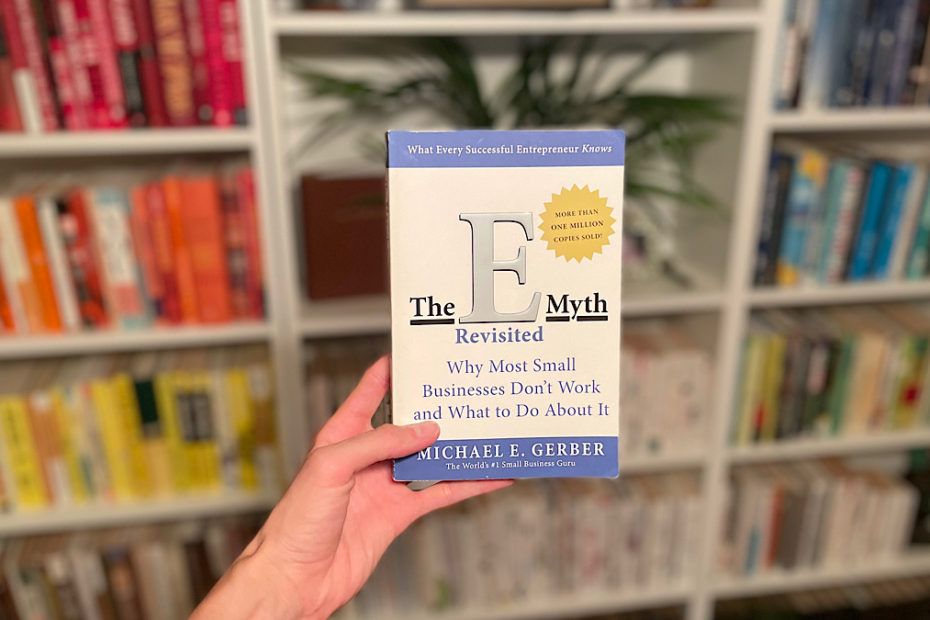The E-Myth Revisited | Book Summary

Book in 3 Sentences
Most entrepreneurs are just like you and me: technicians of their trade. And many of them fail to launch a successful business because they do not take a turn-key approach during the development process. To build a successful business, you must look past the technician lens and view your business as an integrated system that runs like a well-oiled machine.
Impact on Me
In this book, Michael Gerber walks you through the common pitfalls of technician-turned-entrepreneurs and why they fail. They view their business as individual tasks that live in silos rather than a system that works together. He advises all small business owners to take a step back from the day-to-day technician's hustle and invest in building their business structure using the turn-key approach. Meaning you should create your business so that it can be franchised and run by anyone, not just you. He advises entrepreneurs to live by three principles during the business development process: Innovation, Quantification, and Orchestration. Together, these principles are essentially another version of Plan —> Do —> Study —> Act (PDSA), a change-management cycle commonly used in healthcare quality improvement efforts. Both of these include collecting pre-change and post-change data to measure the success of the implemented plan/innovation. A step Gerber finds most small business owners overlook.
However, what stood out to me the most was when Gerber broke down the step-by-step business development process. Step number one was to determine "Your Primary Aim," which requires you to look at your life and decide what you want out of it. This vision will then serve as the driving force for the rest of your business planning and how it will get you to where you want to be. Meaning the business would be the means to an end for your primary aim. In other words, the business would serve me. This idea was so profound because I would never have imagined I could potentially have so much control over my life's outcome. Build a business to support whatever I want out of life? The possibilities are endless.
Since finishing this book, I now see this online journey with a new lens. I am following the below outlined Business Development Program to build a life that makes me happy. There's a long way to go, but I'm looking forward to every second of it.
Who Should Read this Book?
This book would benefit new or aspiring small business owners or entrepreneurs. It is constructive in starting to view your entire business as a system and walking you through how to develop it. I'll admit the book can be a bit drawn out by the stories Gerber inserts into each lesson, but I found them to be helpful examples as I thought about my situation. I most definitely recommend this book if you feel like a small business owner that is stretched thin and burnt out.
Book Summary/Notes (informal)
There are four ideas to owning a successful small business.
- Understanding the E-myth
- Turn-key Revolution
- Incorporate the Business Development Process
- Systematically apply the Business Development Process step-by-step to incorporate lessons from the Turn-key Revolution
The E-Myth
- Entrepreneurs are often seen as superhumans prevailing above all, but this is a myth
- Most entrepreneurs started out doing technical work for someone else's business, and something happened that struck them with an entrepreneurial seizure that made them want to cut the cord
- However, knowing the technical work of a business is not the same work as owning a business
- On top of the technical work that you know and love, owning a business comes with a whole set of other tasks that you don't know how to do
- To build a successful business, you need to manage the three personalities within yourself: the entrepreneur (visionary), the manager, and the technician (the doer)
- Phases of a business: Infancy (technician phase), Adolescence (owner hires technical help but doesn't know how to be a manager), Maturity (vision was set up so the business could survive without the owner)
- Entrepreneurial model = A business model that fulfills a perceived need of a specific subset of customers in an innovative way. It's not about what is done, but how
- It's about how the customer needs the business/product
- The entrepreneur needs to figure out what customers want now and what they want in the future
The Turn-Key Revolution
- All parts of the system must be integrated
- Develop your business so that it can be franchised (pretend)
- Follow the rules below:
The model will provide consistent value to your customers, employees, suppliers, and lenders beyond what they expect.
- What is value? Value is what people perceive it to be
- Understand the value in terms of everyone who interacts with the business
The model will be operated by people with the lowest possible level of skill necessary.
- Create a system that can leverage these ordinary people
- So it can be systems-dependent rather than people-dependent
The model will stand out as a place of impeccable order.
- This gives people comfort in a world of chaos
All work in the model will be documented in operations manuals.
- Gives people the structure they need to get the job done
- Provides clarity
- The model will provide a uniformly predictable service to the customer
- This allows people to choose the experience they want by coming to your business every time
The model will utilize a uniform color, dress, and facilities code.
- These things have some psychological impact on customers
The Business Development Process
Innovation
- Always ask yourself, "What's the best way to do this?" keeping all stakeholders in mind
Quantification
- All innovations need to be quantified related to the impact an innovation makes
- Measure pre- and post-innovation impacts
Orchestration
- Implement your innovation across the business so that it will be consistent every time so customers know what they can expect
Your business should change as the world changes and remain flexible.
Business Development Program
The step-by-step process by which you convert your existing business into a model to create thousands more like it.
#1 Your Primary Aim
- What do I value most? What kind of life do I want? What do I want my life to feel like? How do I wish my life to be on a day-to-day basis?
- What script do you want to be played at the end of your life?
- Without a primary aim, you don't know where you're going in your life
- Live intentionally rather than living accidentally
#2 Your Strategic Objective
- A clear statement of what your business has to do for you to achieve your primary aim
- Your business is a means rather than an end
- The business strategy and plan communicate the direction the business is going
- Standards to include: money and opportunity
- Money = gross revenues; how big will it be; gross profits (pre-tax and post-tax profits); how much money do I need to live the way I want?
- Is it an opportunity worth pursuing? = does the business I have in mind alleviate something for a large enough amount of consumers? Know the difference between commodity (item consumer walks out with) and product (how a consumer feels about the interaction)
#3 Your Organizational Strategy
- You need an organization chart because mobs don't get things done
- By creating a chart, you outline the work that needs to be done and set the standards that person is accountable for
- No matter the size, the work doesn't change, but the names/faces do
#4 Your Management Strategy
- You need a management system, not a superior manager
- Management system = a system designed into your franchise prototype to produce a marketing result. The more automatic it is, the more successful your prototype will be
#5 Your People Strategy
- "How do I get my people to do what I want?" You can't. If you want it done, then you need to create an environment that incentivizes people to do well
- "The work we do is a reflection of who we are."
- Give everyone an idea behind the work that is more important than the work itself
- Create an environment where work is a game to be played with rules employees should act and play within
#6 Your Marketing Strategy
- Think about what your audience wants, not what you want
- Customers don't know what they want, so you can't know either
- Determine your customers' demographics and psychographic preferences
- Find a perceived need and fill it
- What must our business be for our customers to choose us over others?
#7 Your Systems Strategy
- A set of things, actions, ideas, and information that interact with each other and, in so doing, alter other systems
- Three kinds of systems in a business: hard (inanimate things), soft (animate or ideas), and information systems
- All systems have structure (what you do) and substance (how you do it)
- Create a standardized process (soft system) for everything and have an information system that informs system progress
- All parts of your strategy should be interdependent
Live with Your Spirit
- Caring gives things meaning (not the other way around)
- Freedom is the ability to become who we really are
- Stay out of your comfort zone
- A business becomes a symbol of the way the entrepreneur wants to live

